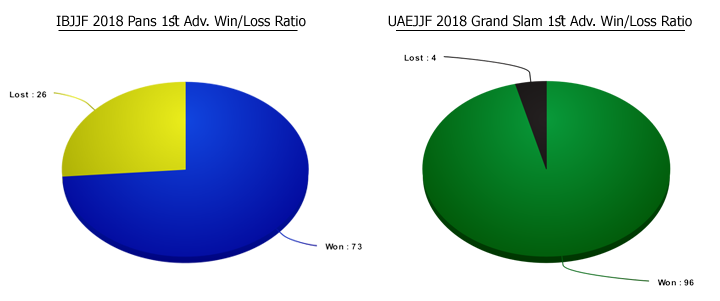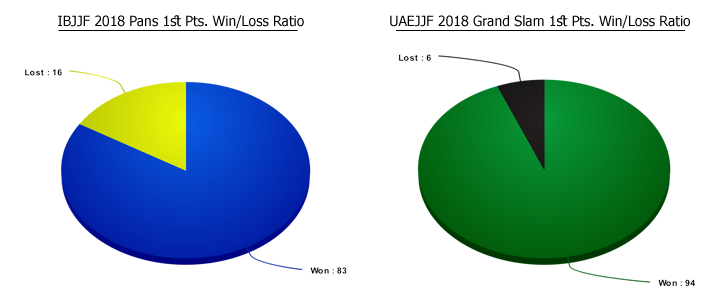Every year, after every major tournament in jiu jitsu’s calendar BJJ Heroes tries to dig through the stats on these events, and produce relevant information regarding the overall competition. We do this in the hope that we learn how each event transforms our sport’s landscape.
Last year, after providing the all encompassing numbers on the International Brazilian Jiu Jitsu Federation (IBJJF) World Championship (see here), we dug deeper and produced the intricacies of the guard (see here). Which guards were being used the most, which were being most effective and how that translated in jiu jitsu’s toughest competitive environment. Today, after the IBJJF Pan American Championship – arguably the 2nd most important gi event in the world, we focus on the importance of being first in a sport that is often (mis)represented as a counter striking martial art. But before we bury ourselves in the details, here is the overall information on the 2018 IBJJF Pans Championship:
In the adult men’s black belt division the tournament presented 115 matches, less than the 175 bouts seen in 2017 or the 142 of 2016. The reason for this shortage is easily explained: As of this year the Pan American Championship is no longer an open tournament. Athletes needed to score points in the organization’s international circuit to qualify for the big show. This measurement has totally weeded out “sunday competitors” from the 2nd biggest tournament in BJJ.
In terms of how this new rule affected the overall outcome of the tournament, the data surprisingly shows very similar numbers to previous years, with the submission ratio stagnant and a slight interchange between advantage and points wins.
2018 IBJJF Pans Matches observed: 115
– Matches won by advantages: 20%
– Matches won on points: 36%
– Matches won by submission: 37%
– Matches won by other: 5%
2017 IBJJF Pans Matches observed: 175
– Matches won by advantages: 11%
– Matches won on points: 42%
– Matches won by submission: 40%
– Matches won by other: 7%
Changes do indeed occur when comparing this weekend’s Pan American Championship with the other big tournament of the weekend, which operated on the same schedule. The UAEJJF Grand Slam Tour held in London, England, which showed a 10% decrease in submissions.
2018 UAEJJF Grand Slam Matches observed: 68
– Matches won by advantages: 18%
– Matches won on points: 47%
– Matches won by submission: 28%
– Matches won by other: 7%
With a similar levels of competition and rules, the big difference between these two federations and their boundaries are the time limits. The IBJJF standard black belt adult matches being 10 minutes long against the UAEJJF’s 6. This 4 minute difference is of massive importance in relation to the subject of this piece:
THE IMPORTANCE OF BEING FIRST IN A JIU JITSU MATCH
Many modern day coaches address the issue of being first when competing. The first to impose a dominant grip, the first to pull guard, the first to score, etc. But how important is this at the highest level? At the IBJJF Pans we went through the 115 black belt adult matches to try and find out:
First to score advantage:
In the 42 matches that started with an advantage being scored at the 2018 IBJJF Pans, 31 of those advantage scorers came out with their hand raised. This means that an athlete who opened the scoreboard with an advantage improved the likelihood of victory by 73%. As important as this may sound, when assessing the stats of the UAEJJF Grand Slam – London those numbers are even more staggering: A 96% victory ratio to the athlete who scored an advantage first.

The math is easy to make here as well, and it all boils down to the aforementioned time limits. With less time on the clock to rebound from a mistake the first to slip on the scoreboard will be battling incredible odds.
Although the odds are still against the slow starter in a 10 minute bout, the more skilled athlete does have a stronger chance of overcoming this disadvantage and shining through to steal the win. But what if we stack the odds even higher?
First to score points:
If starting the match losing by a minimal advantage is of huge importance to the outcome of success, slipping up on the points should be a death sentence. Indeed the numbers agree with this logic. At the Pans this was proven with the man who scored first winning 65 out of 73 matches – 6 out of the remaining 13 matches, the comebacks, being obtained by way of submission. At the Grand Slam the stats also follow the trend for the first to reach the coveted starting points, while no submissions were obtained in the lonely 3 comebacks throughout the whole black belt adult division.

And what of the guard pull, does it affect the overall outcome?
A good guard pull, in many cases may define a match. This happens more in the lower weight classes but is also valid in the heavier division. How did guard pullers fair among the grappling elites?
As expected the guard pull was extremely popular at the IBJJF Pans, with 99 out of the 115 matches having at least one guard pull in regulation. The results, however, were extremely divided:
– Guard Puller: 47 Wins
– Guard Puller: 36 Loss
– Double Pull: 16*
* All but 1 Double Guard Pull Occurred on the Rooster, Light-Feather and Featherweight Divisions.
Another important element to the very start of the match, the takedown was used 11 times across the Pans as a way to open the score. On all 11 occasions victory was handed to the athlete who scored in the exchange, a massive asset to have – the ability to score from standing.
CONCLUSION
If there were any doubts on the importance of starting your match with confidence and points on the board, those should have been put to rest here. Depending on the ruleset, the ability to dictate the pace of a match after is an asset sometimes overlooked in training, and we hope this may be used to improve your own approach to the sporting aspect of BJJ, be it as a coach or an athlete.
Cover photo by Blanca Marisa Garcia.















